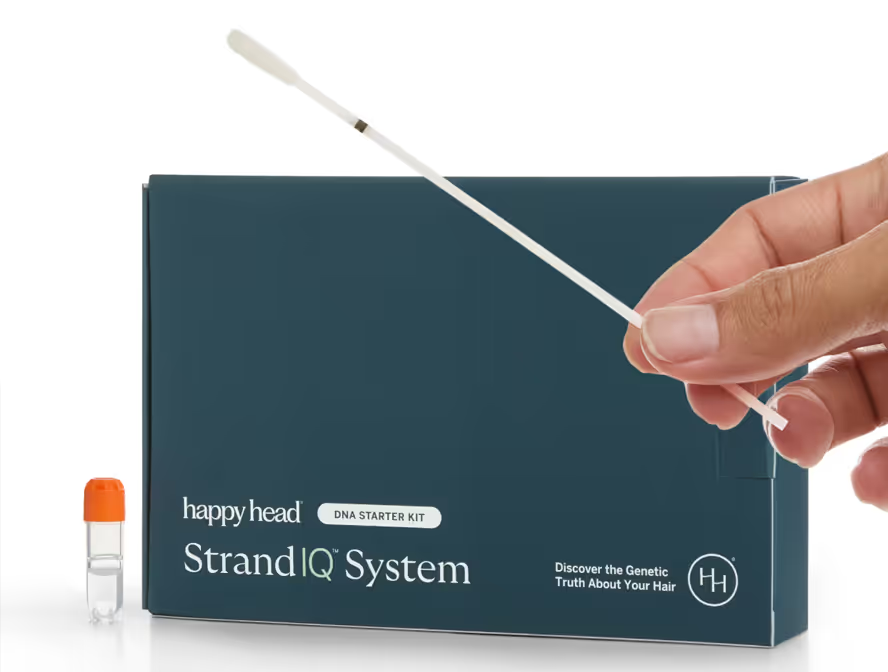Copper is a trace mineral with an outsized role in hair and scalp health. It supports the production of collagen and melanin, two elements essential for hair structure and color. Collagen strengthens the follicle’s connective tissue, while melanin protects pigment, helping hair maintain its natural tone longer.
Copper also contributes to antioxidant enzyme activity and iron metabolism, which influence blood flow to the scalp and follicle anchoring.
How Weak Copper Processing Affects Hair
Genetic variants that influence copper efficiency can subtly impact hair over time. Reduced activity of copper-dependent enzymes may limit follicle support, melanin production, and scalp resilience.
Key effects may include:
- connective tissue weakening, making hair more prone to shedding
- delayed healing after scalp irritation or minor injuries
- dull or depigmented hair from reduced melanin synthesis
- synergistic impact with stress or illness, accelerating hair changes
Dietary awareness and professional guidance from Happy Head can help support strong, vibrant, and well-anchored hair, even in the presence of genetic risk.
The Role Genetics Play in Copper Deficiency
While dietary intake is important, genetics can also significantly influence how your body absorbs, transports, and utilizes copper. Certain genetic variants affect the proteins involved in intestinal absorption, cellular transport, and enzymatic activation of copper, creating a higher risk for functional deficiencies even when dietary intake appears adequate.
Key mechanisms include:
- Reduced copper transport and storage – Variants that affect copper-carrying proteins can limit delivery to tissues such as the scalp and hair follicles, where copper is needed to form collagen and melanin.
- Lower efficiency of copper-dependent enzymes – Enzymes that rely on copper, such as those supporting antioxidant defense and connective tissue repair, may function less effectively in individuals with reduced processing efficiency.
- Increased vulnerability under stress or illness – When copper metabolism is genetically less efficient, periods of physical stress, rapid tissue repair, or nutrient imbalance can exacerbate hair weakening, shedding, or premature greying.
Understanding your genetic profile can help determine whether diet alone is sufficient or if professional monitoring and tailored strategies are necessary to maintain optimal scalp and hair health.
Recommendations Based on Genetic Risk
These recommendations are tailored to your Happy Head StrandIQ analysis-determined copper processing efficiency to help maintain strong, pigmented hair and a resilient scalp.
Low Risk: Maintain Adequate Dietary Copper
If you’ve been identified as being at low genetic risk for weak copper processing, you’ll likely be able to meet your hair goals through diet alone. However, including a variety of copper-rich foods ensures ongoing support for hair strength and scalp health.
- Include seafood and organ meats
Foods such as oysters, crab, shrimp, and organ meats (liver, kidney) provide highly bioavailable copper that supports collagen and melanin production. - Incorporate plant-based sources
Beans, avocado, potatoes, leafy greens, and shiitake mushrooms supply copper while adding beneficial fiber and micronutrients. - Supplement with snacks
Whole grains, nuts, spirulina, and dark chocolate are additional sources that can help maintain copper status in a typical diet.
Medium Risk: Increase Dietary Variety and Monitor Intake
If your StrandIQ analysis found you to be at a moderate genetic risk, your body may be less efficient at copper utilization. This is when maintaining optimal intake becomes more important.
- Prioritize nutrient-dense animal sources
Oysters, crab, shrimp, mussels, and organ meats are among the richest copper sources and can be incorporated into regular meal planning. - Introduce diverse seafood options
Rotating in scallops or other shellfish can help increase dietary coverage while maintaining variety. - Supplement with caution
Copper supplementation should only be considered under medical or dietitian supervision, as excessive intake may interfere with other minerals or lead to toxicity.
High Risk: Prioritize Bioavailable Sources and Professional Oversight
For those identified as being at a high genetic risk, copper processing may be significantly reduced, which can affect collagen synthesis, melanin production, and hair anchoring. In these cases, a targeted, monitored approach is recommended.
- Focus on highly bioavailable dietary sources
Include organ meats and shellfish routinely, as these provide copper in its most absorbable form for supporting follicle stability and pigment retention. - Utilize plant-based and ancillary sources
Foods such as beans, leafy greens, potatoes, nuts, and dark chocolate help round out dietary intake and provide additional antioxidant support for scalp tissues. - Seek professional monitoring
Work with your physician to track copper levels and ensure your intake aligns with individual needs. Check for imbalances in zinc or iron, which can interfere with copper function. - Approach supplementation cautiously
Copper supplements should never be self-administered, as excess intake can result in oxidative stress or mineral imbalance.
Supporting Hair and Scalp Health With Copper
Maintaining healthy copper levels can preserve natural color, strengthen follicles, and enhance scalp repair. If you are genetically predisposed to weak copper processing, a nutrient-diverse diet and professional monitoring can help prevent early greying and improve long-term hair resilience.
Resources
StrandIQ SNP Marker Count: 9
StrandIQ Genes for Trait:
ANK2, ANK2-AS1, CCDC27, LRRC47, OR7A5, OR7C1, SELENBP1, SHISA9, SMIM1
References:
Flatby, H. M., et al. (2023). Circulating levels of micronutrients and risk of infections: a Mendelian randomization study. BMC Medicine, 21, 84. PMID: 36882828.
Huang, T., & Lu, F. (2024). Genetically predicted circulating concentrations of micronutrients and risk of hypertensive disorders of pregnancy: a Mendelian randomization study. Archives of Gynecology and Obstetrics, 310, 1019–1025. PMID: 38194093.
Jäger, S., et al. (2022). Blood copper and risk of cardiometabolic diseases: a Mendelian randomization study. Human Molecular Genetics, 31(5), 783-791. PMID: 34523676.
Kodali, H. P., et al. (2018). Effects of copper and zinc on ischemic heart disease and myocardial infarction: a Mendelian randomization study. American Journal of Clinical Nutrition, 108(2), 237–242. PMID: 29982268.
Liu, K., et al. (2024). Genetically determined circulating micronutrients and the risk of nonalcoholic fatty liver disease. Scientific Reports, 14(1), 1105. PMID: 38212362.
Moksnes, M. R., et al. (2024). A genome-wide association study provides insights into the genetic etiology of 57 essential and non-essential trace elements in humans. Communications Biology, 7, 432. PMID: PMID: 38594418.
Ng, E., et al. (2015). Genome-wide association study of toxic metals and trace elements reveals novel associations. Human Molecular Genetics, 24(16), 4739-4745. PMID: 26025379.
Yang, W., et al. (2022). Genome-wide association and Mendelian randomization study of blood copper levels and 213 deep phenotypes in humans. Communications Biology, 5(1), 405. PMID: 35501403.
Yang, Z., et al. (2024). Causal relationship of serum micronutrient with autoimmune neurological diseases: a Mendelian randomization study. Preprint, Research Square. https://doi.org/10.21203/rs.3.rs-4590504/v1
This content, including StrandIQ™ DNA analysis reports and any Happy Head products and/or services referenced therein, is for informational and cosmetic purposes only. It is not intended to diagnose, treat, cure, or prevent any disease. This content does not constitute medical advice and should not be used to make healthcare decisions. References to prescription treatments are educational in nature. Always consult a licensed healthcare professional for any medical concerns or treatment decisions.








.avif)

